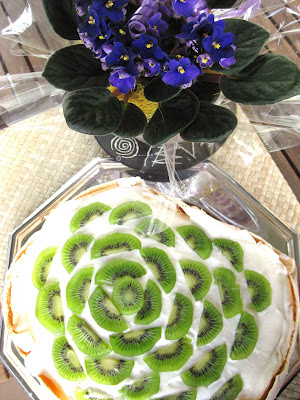I know! It is a long time I don´t write anything. But this is because I had to follow an special diet as I am pregnant, and sugar was not in the list!. This is an exception as I wanted to celebrate a very special day cause my niece Bruna is now one week old. She is sooo cute.
The dessert today is coca de vidre (or coques de vidre, in plural), that is a typical catalan thing. Vidre in catalan means glass, because it is very thin and easy to break, and also because when you pour the anisette into the flatbread right after the oven, this mix with anisette and sugar crystalizes. Of course you can make small rounded pieces and you will have a cookie instead, but normally it is like a bigger portion. You can find them in Catalonia, but more likely around Barcelona area (it was created in Sabadell...my city!).
The clue here is using the flour you will use for making a pizza (or just buy a thin fresh pizza base) and also the other important thing here is the anisette. I don´t know if you can find this in some other countries. All the people here use one that is called Anís del Mono (anisette from the monkey, yes quite weird name...it was created some time ago, when Darwin was claiming about the theory of evolution) (you can find it in any supermarket). You have to pour the anisette just right after the oven. Another key factor is trying to make the coca as thin as you can. I guess some of you will have a hard time finding anisette .....sorry!A nice woman from California (Loran) wrote me some weeks ago after visiting Barcelona and she found it so delicious that asked me for the recipe. It also can be called Coca de Caramel, but it is not the official name.
I am going to post the easy recipe today for it, that I got it from another blog (La cuina de casa), that it is so easy.
What you need:
a fresh pizza base
oil
pine nuts (or laminated almonds)
sugar
anisette
Let´s start
1.Just roll out the dough (Fresh pizza base) using a rolling pin. Shape it the way you like it. But make it a very thin layer.
2. Put oil on top (paint the coca)
3. Put the pine nuts and sugar (be generous!)
4. Introduce it into the oven for 10-15 minutes 180-220ºC (around 400F)
5. Pour the anisette just right after you remove it from the oven. It will react and it is going to crystalize.
2. Put oil on top (paint the coca)
3. Put the pine nuts and sugar (be generous!)
4. Introduce it into the oven for 10-15 minutes 180-220ºC (around 400F)
5. Pour the anisette just right after you remove it from the oven. It will react and it is going to crystalize.
That is ALL!!
There are also some videos where you can get the difficult recipe, where you prepare the pizza base instead of buying it. Have a look at these videos
http://youtu.be/JIwMPNHfEoA (they use almonds instead of pine nuts, but it is not very common but it taste good anyway..)
(oli is oil, farina is flour, sucre is sugar, ametlles is almonds, anís is anisette, sal is salt, aigua tebia is warm water, 2 cullerades means 2 tablespoons) (deixar reposar la massa 15 minuts, is let the dough stand for 15 minutes).
http://youtu.be/CEWRwr0qX90 (they don´t put pine nuts...)
Enjoy/ Bon Profit
















